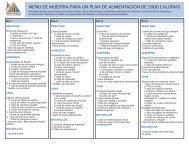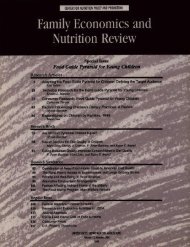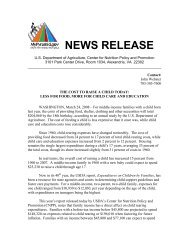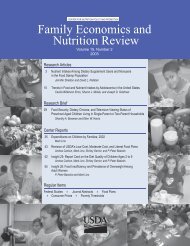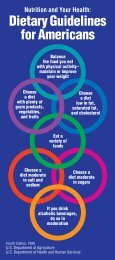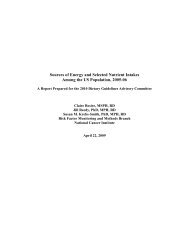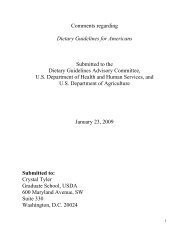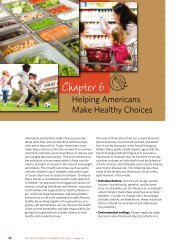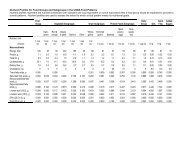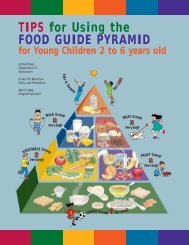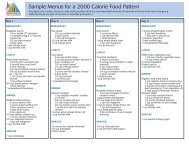Elderly Nutrition - Center for Nutrition Policy and Promotion - US ...
Elderly Nutrition - Center for Nutrition Policy and Promotion - US ...
Elderly Nutrition - Center for Nutrition Policy and Promotion - US ...
Create successful ePaper yourself
Turn your PDF publications into a flip-book with our unique Google optimized e-Paper software.
Healthy Eating Index Scores<br />
<strong>and</strong> the <strong>Elderly</strong><br />
Michael S. Finke, PhD<br />
University of Missouri-Columbia<br />
S<strong>and</strong>ra J. Huston, PhD<br />
University of Missouri-Columbia<br />
This study explored the positive relationship between advanced age <strong>and</strong> scores<br />
on the Healthy Eating Index (HEI). It did so by comparing component as well as<br />
total HEI scores of different age groups <strong>and</strong> by estimating the independent effect<br />
of age, among other demographic variables, on HEI scores. The elderly, compared<br />
with younger age groups, had higher HEI scores on the fruits, sodium,<br />
<strong>and</strong> cholesterol components. Results also showed that the independent effect<br />
of advanced age upon component scores, as well as upon the total HEI scores,<br />
is notably strong. Results provide insight into the relationship between age <strong>and</strong><br />
healthful eating.<br />
T<br />
he Healthy Eating Index (HEI)<br />
provides a numerical yardstick<br />
of diet quality based on the<br />
Food Guide Pyramid (U.S. Department<br />
of Agriculture [<strong>US</strong>DA], 1996) <strong>and</strong> the<br />
Dietary Guidelines <strong>for</strong> Americans<br />
(<strong>US</strong>DA & U.S. Department of Health<br />
<strong>and</strong> Human Services [DHHS], 1995).<br />
It was designed to evaluate diets<br />
according to a more contemporary<br />
underst<strong>and</strong>ing of healthful eating,<br />
one that recognizes the role of overconsumption<br />
<strong>and</strong> poor diet choice as<br />
contemporary public health problems<br />
(Kennedy, Ohls, Carlson, & Fleming,<br />
1995).<br />
Previous study of HEI scores among<br />
demographic groups reports that age<br />
may be associated with more careful<br />
choices of nutritious foods (Basiotis,<br />
Hirschman, & Kennedy, 1996; Gaston,<br />
Mardis, Gerrior, Sahyoun, & An<strong>and</strong>,<br />
2001). In fact, healthful eating as it is<br />
currently defined is highest among<br />
those in the oldest age categories<br />
(McDonald & Webster, 1998; Bowman,<br />
Lino, Gerrior, & Basiotis, 1998).<br />
This result is surprising given the<br />
potential impediments to a nutritious<br />
diet such as lower average nutrition<br />
knowledge <strong>and</strong> diet-health awareness<br />
(McDonald & Webster, 1998), reduced<br />
mobility, lower average educational<br />
attainment, financial resources (Administration<br />
on Aging, 2003), <strong>and</strong> even<br />
receptiveness (Bernheim, 1990) to<br />
new in<strong>for</strong>mation among the elderly.<br />
Further exploration of the HEI <strong>and</strong> its<br />
components is needed to underst<strong>and</strong><br />
better the relationship between advanced<br />
age <strong>and</strong> higher HEI scores.<br />
Gaston et al. (1999) note that mean<br />
scores among the elderly may be<br />
attributed to reduced consumption<br />
of food energy, which leads to better<br />
scores <strong>for</strong> components (e.g., fat,<br />
saturated fat, cholesterol, <strong>and</strong> sodium)<br />
that penalize <strong>for</strong> overconsumption.<br />
Compared with younger groups, the<br />
elderly also appear to consume more<br />
fruits. Identifying the independent<br />
effect of age on HEI components may<br />
provide insight into elderly nutrition<br />
<strong>and</strong> ultimately into the factors leading<br />
to variation in HEI scoring.<br />
The HEI score comprises 10 components<br />
that represent different aspects<br />
of a healthful diet. The first five components<br />
measure adherence to the food<br />
groups of the Food Guide Pyramid:<br />
grains, vegetables, fruits, milk, <strong>and</strong><br />
meat. Components 6 <strong>and</strong> 7 measure<br />
total fat <strong>and</strong> saturated fat consumption,<br />
2003 Vol. 15 No. 1 67



